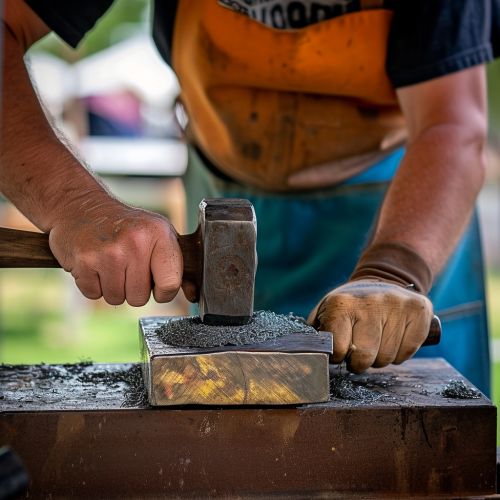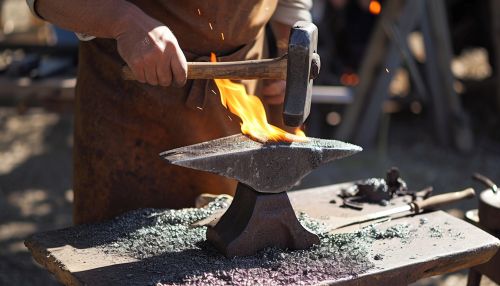Metalworking
Introduction
Metalworking is a process that involves the creation of objects from metals. It is a broad term that covers a wide range of techniques and skills, from the simple bending and shaping of a metal sheet to the complex processes used in the production of intricate machine parts. This article will delve into the various aspects of metalworking, including its history, techniques, tools, and applications.
History of Metalworking
The history of metalworking dates back to the earliest human civilizations. The discovery and utilization of metals marked a significant turning point in human history, leading to advancements in technology and the development of complex societies.
Prehistoric Metalworking
The earliest evidence of metalworking can be traced back to the Copper Age, also known as the Chalcolithic period, around 7000 BC. Early humans discovered that certain rocks, when heated, produced a substance that could be shaped and hardened. This substance was copper, the first metal to be worked by humans.
Bronze Age
The Bronze Age, which began around 3000 BC, marked a significant advancement in metalworking. During this period, humans discovered that by alloying copper with tin, they could create a stronger and more durable metal: bronze. This led to the development of new tools and weapons, and the expansion of trade networks.
Iron Age
The Iron Age, which began around 1200 BC, saw the introduction of ironworking. Iron was more abundant and stronger than bronze, leading to its widespread use in tools, weapons, and construction materials. The techniques used to work iron, such as smelting and forging, were more complex than those used for bronze, requiring a higher level of skill and knowledge.
Techniques of Metalworking
Metalworking involves a variety of techniques, each with its own set of tools and processes. These techniques can be broadly categorized into forming, cutting, and joining.
Forming
Forming is the process of shaping metal without removing material. This can be done through various methods such as bending, forging, and drawing.


Bending
Bending involves deforming metal into a curved or angular shape. This is typically done by applying force to the metal using a hammer or press.
Forging
Forging is a process where metal is heated until it becomes malleable and then shaped by striking with a hammer or press. The heat makes the metal more ductile, allowing it to be deformed without breaking.
Drawing
Drawing is a process where metal is pulled through a die to reduce its cross-section. This technique is commonly used in the production of wire and tubing.
Cutting
Cutting is the process of removing material from a workpiece. This can be done through various methods such as sawing, shearing, and machining.
Sawing
Sawing involves cutting through metal using a saw. The teeth of the saw remove material as they move back and forth, creating a cut or groove in the metal.
Shearing
Shearing is a process where metal is cut without the formation of chips or the use of burning or melting. This is typically done using a machine known as a shear.
Machining
Machining is a process where metal is cut using a machine tool. This can involve various techniques such as turning, milling, and drilling.
Joining
Joining is the process of connecting two or more pieces of metal. This can be done through various methods such as welding, brazing, and riveting.
Welding
Welding is a process where two pieces of metal are joined by melting the surfaces to be joined and adding a filler material to form a pool of molten material that cools to become a strong joint.
Brazing
Brazing is a process where a filler metal is heated above its melting point and distributed between two or more close-fitting parts by capillary action. The filler metal is brought slightly above its melting (liquidus) temperature while protecting it with a suitable atmosphere, usually a flux.
Riveting
Riveting is a process where a metal pin or bolt is used to join two pieces of metal. The rivet is inserted into a hole and then deformed on both ends to hold the pieces together.
Applications of Metalworking
Metalworking is used in a wide range of industries and applications, from the production of everyday objects to the manufacture of complex machinery and infrastructure.
Manufacturing
In the manufacturing industry, metalworking is used to produce a wide range of products, from household appliances to automotive parts. Techniques such as forming, cutting, and joining are used to shape and assemble metal components.
Construction
In the construction industry, metalworking is used in the production of structural components such as beams and columns. Metal is also used in the fabrication of roofing materials, plumbing fixtures, and electrical systems.
Art and Craft
In the field of art and craft, metalworking is used to create sculptures, jewelry, and decorative items. Artists and craftsmen use techniques such as forging, casting, and welding to shape and join metal in creative ways.
